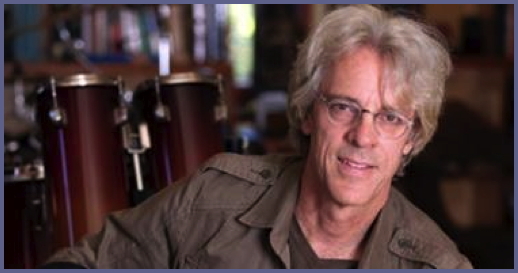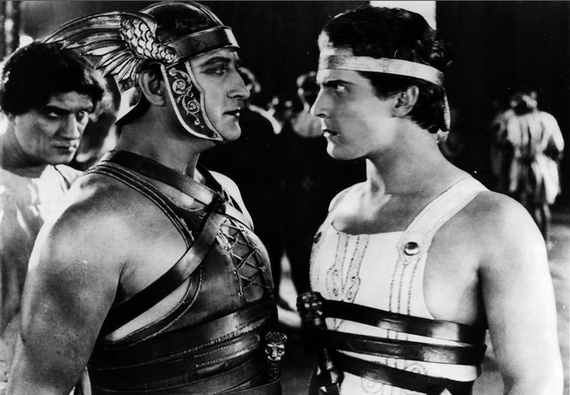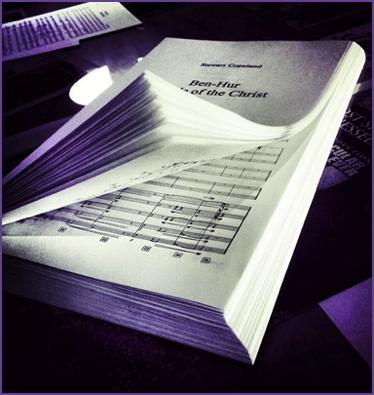Metro-Goldwyn-Mayer's 1925 silent epic, Ben-Hur: A Tale of the Christ, has been revitalized with a new score composed by famed drummer Stewart Copeland. Arranged as a specially-edited 90-minute concert presentation, the world premiere will take place on Saturday, April 19 at the Virginia Arts Festival in Norfolk, Virginia.
Richard Kaufman will lead the Virginia Arts Festival Orchestra with Copeland on drums. The idea of it all started with music that Copeland had written for a 2009 arena production of Ben-Hur that opened at the O2 Arena in London.
"They staged Ben-Hur live on the floor of the arena," said Stewart during our recent interview. "The chariot race, the pirate ship battle, the whole story! It played all over Europe, ending up in Rome for several months. Next year it's going to Seoul. It started out as a work-for-hire, but I ended up owning the copyright, the recordings, everything. I recorded the orchestra in Bratislava, I went to Istanbul, recorded in London and Los Angeles -- building the soundtrack for this stage production. Then I wanted to do a concert of some of this material. It occurred to me that it would be cool to have a backdrop of some Ben-Hur images, something visual to go along with the music.
That got me to this 1925 version which is included in the 1959 Ben-Hur box set. Then, looking at the movie -- with my music alongside it -- I realized I had the Messala theme, the friendship-gone-wrong theme, the music for Jesus, and a poignant and beautiful theme for Mary. I have a huge piece of music for the pirates, a huge piece for the chariot race, and all the scenes in-between. As I'm putting the music with the movie, I'm realizing what a masterpiece this film really is. All my ideas of any other Ben-Hur imagery went by the wayside and I just began to concentrate more and more on this version."
In 1924, Irving Thalberg was Head of Production at the newly formed Metro-Goldwyn-Mayer Studios. He renewed young Ramón Novarro's contract and hired him to play the title role in Ben-Hur: A Tale of the Christ. The film and all its mis-management had originated at Metro Pictures and came with the merger. Thalberg decided to save it. After all, the 1880 novel by General Lew Wallace was still the hottest-selling book around. Folks everywhere knew the movie version was in progress and that George Walsh (brother of director Raoul Walsh) was playing Ben-Hur. In hindsight, George was a really odd choice.
He was 35 at the time and not exactly in the same league with other romantic leading men at the various competing studios. Novarro was 25, attractive, a refugee of the Mexican revolution. As with Valentino, Ramón Novarro would have been described as, "exotic." More importantly, his films were making money. What Thalberg needed in his "Ben-Hur" was a man who was convincing in his resistance to the seductive charms of a woman -- any woman, and who could feasibly remain steadfast and faithful to a greater cause. Novarro was that man. George had to go.
"From the outset, I was thinking of a 60-minute version out of the film's two hours and twenty minutes. But then I got involved with it and ended up with ninety minutes. I left out a few subplots, but what I've kept forms a through line. The story of the two men and their life-long rivalry is there. The story of Simonides' daughter, Esther, being the property of Judah Ben-Hur is there. And, of course, the main action scenes are all there. Another element -- which wasn't so much in the Charlton Heston version but is very important in this film -- is the spiritual element.
The title of the 1925 film is, Ben-Hur: A Tale of the Christ. That aspect of it is deeply moving. I am neither libertarian or liberal. I'm a libertine, a West Coast sinner. But I'm deeply moved by these hugely powerful religious scenes. You don't see Jesus, you see his hand. You see his works. Neither of the films really does justice to General Lew Wallace's point, which is the last line of the book -- "Rome is gone, but Jesus is still here." It's kind-of hard to show that in a movie, because the characters that are standing there wouldn't know that. This film does its best. Judah gathers his family around him and says, "We will endure and Rome will fall." The spiritual message is that love is the answer. And I agree. So, that aspect of the film is very much there."
Living near San Francisco's Castro Theatre makes it convenient for me to attend two major annual film festivals that focus on vintage films -- the Silent Film Festival and Noir City. Each festival celebrates the latest developments in science and technology that have advanced the art of film restoration and preservation. The events include films that have recently benefited from these rescue missions, especially those that were thought to be lost or beyond repair.
At Davies Symphony Hall, the San Francisco Symphony attracts huge crowds when it takes over the music tracks of classic films such as Casablanca or at Halloween when the world's great organists are invited to play around with the 9,235 pipes of its Ruffatti organ for a silent horror - such as last season's presentation of Alfred Hitchcock's The Lodger. I asked Stewart to describe his technical adventures with the edited print of Ben-Hur: A Tale of the Christ and have it ready to go by Easter Weekend for the Virginia Arts Festival.
"The film I'll be showing is not the DVD version. I went to Warner Brothers and it took about two years to navigate through the departments and the inter-departments and between the departments for this very strange hybrid concept of a show. It really wasn't anybody's 'division' over there. So, it took us quite a while to get them to agree to let us use the movie. Not to just let us play the movie, but to actually dig out the eighty-year-old celluloid from the deep freeze and telecine it. The film took ten days to defrost. It's the first time the film has been out of its cans since the '60s when they shot it for the video. The present DVD derives from that video.
"Believe me, Turner Classics, which is Warner Brothers, is very dedicated to this mission. Once I found the people who actually curate this stuff - off in a dark corner of the lot - they became dedicated to getting it right. These people live and breathe this stuff. They were able to educate me as to the peculiarities of each different camera producing a different frame on the screen.
I originally cut my music and the film using the DVD version which was telecined back in the '60s. It turns out, when we shot the original movie -- which was running somewhere between eighteen and twenty-two frames a second, depending on who was cranking that day -- all the shots have a slightly different duration. Running at that slow speed, there is no way of playing it properly. So you have to go at 24 frames a second. How do you accommodate? There are only two things you can do. Replicate every fourth frame or run it slightly fast. I went with the latter just because it seems smoother. It just feels better for the whole film to run naturally albeit a little fast. It still has majesty to it. I am so bonded with this version!"
Audiences will no doubt notice the film's many similarities to the 1959 production directed by William Wyler, specifically the magnificent sea battle and chariot race. Dramatically and cinematically, the scenes in the later film are not necessarily better nor does color enhance the thrills of the action and all the mega violence. What is more spectacular (perhaps, of greater mythic appeal) in director Fred Niblo's 1925 version is the entire scope of the nativity scene which begins with the title card: "It was the 24 day of December."
The special effects created for the Wise Men's guiding light are daunting. The traveling star of 1925 is surrounded by a halo that is far more lively than the simple ring that encompasses the light of 1959. Also, the arc of its descent across the screen is more like a comet followed by a trail of shimmering dust which, in the star's final position, cascades over the place in the little town of Bethlehem. The star then begins to pulsate, sending out rings of light that must have awakened and quaked every shepherd and flock nearby. The celestial phenomenon settles into a familiar Christmas card image depicting cross-shaped rays emanating from the star.
"The other thing I bring to this," said Steven, "is that I grew up in the Levant -- in Beirut, Lebanon. Before that, in Cairo. I'm steeped in the music of that area. The score is very Middle Eastern. It's symphonic, but it's a very Middle Eastern sound, the rhythms are Middle Eastern. I'm playing through much of the show, so it's much more rhythmic. I hope the ethnicity of the score will stand out. The orchestral score is about two thousand pages including the parts. So, let me ask you a question. Since you are obviously very steeped in the world of old films -- how do you feel about seeing a ninety minute version of this one?"
My response was that I'm always anxious to hear a new scoring for a silent film. The dream, of course, would be to have him complete the project. But, for now, in the hands of conductor Richard Kaufman, with the Virginia Arts Festival Orchestra at Chrysler Hall, during Easter 2014, in the company of fellow film enthusiasts in Norfolk who are getting a spruced-up and maybe first time introduction to two immortal Hollywood stars from the early Twenties -- Ramón Novarro and Francis X. Bushman -- I am consumed by my sin of envy.


